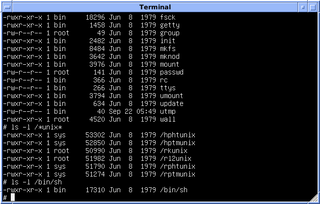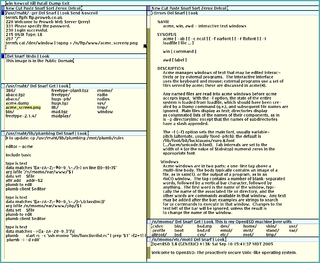Historical context
Although Unix still exists decades after the publication of this book, the book describes an already mature Unix: In 1984, Unix had already been in development for 15 years (since 1969), it had been published in a peer-reviewed journal 10 years earlier (SOSP, 1974, "The UNIX Timesharing System"), and at least seven official editions of its manuals had been published (see Version 7 Unix). In 1984, several commercial and academic variants of UNIX already existed (e.g., Xenix, SunOS, BSD, UNIX System V, HP-UX), and a year earlier Dennis Ritchie and Ken Thompson won the prestigious Turing Award for their work on UNIX. The book was written not when UNIX was just starting out, but when it was already popular enough to be worthy of a book published for the masses of new users that were coming in.
In retrospect, not only was 1984 not an early stage of Unix's evolution, in some respects it was the end of Unix evolution, at least in Bell Labs: The important UNIX variants had already forked from AT&T's Research Unix earlier: System V was published in 1983, BSD was based on the 1979 Seventh Edition Unix – and most commercial Unix variants were based on System V, BSD, or some combination of both. Eighth Edition Unix came out right after this book, and further development of UNIX in Bell Labs (the Ninth and Tenth Edition) never made it outside Bell Labs – until their effort evolved into Plan 9 from Bell Labs.

Brian Wilson Kernighan is a Canadian computer scientist. He worked at Bell Labs and contributed to the development of Unix alongside Unix creators Ken Thompson and Dennis Ritchie. Kernighan's name became widely known through co-authorship of the first book on the C programming language with Dennis Ritchie. Kernighan affirmed that he had no part in the design of the C language.

Dennis MacAlistair Ritchie was an American computer scientist. He created the C programming language and the Unix operating system and B language with long-time colleague Ken Thompson. Ritchie and Thompson were awarded the Turing Award from the Association for Computing Machinery (ACM) in 1983, the IEEE Richard W. Hamming Medal from the Institute of Electrical and Electronics Engineers (IEEE) in 1990, and the National Medal of Technology from President Bill Clinton in 1999.

Plan 9 from Bell Labs is a distributed operating system which originated from the Computing Science Research Center (CSRC) at Bell Labs in the mid-1980s and built on UNIX concepts first developed there in the late 1960s. Since 2000, Plan 9 has been free and open-source. The final official release was in early 2015.
troff, short for "typesetter roff", is the major component of a document processing system developed by Bell Labs for the Unix operating system. troff and the related nroff were both developed from the original roff.
Yacc is a computer program for the Unix operating system developed by Stephen C. Johnson. It is a lookahead left-to-right rightmost derivation (LALR) parser generator, generating a LALR parser based on a formal grammar, written in a notation similar to Backus–Naur form (BNF). Yacc is supplied as a standard utility on BSD and AT&T Unix. GNU-based Linux distributions include Bison, a forward-compatible Yacc replacement.

The system utility fsck is a tool for checking the consistency of a file system in Unix and Unix-like operating systems, such as Linux, macOS, and FreeBSD. The equivalent programs on MS-DOS and Microsoft Windows are CHKDSK, SFC, and SCANDISK.

The Bourne shell (sh) is a shell command-line interpreter for computer operating systems. It first appeared on Version 7 Unix, as its default shell. Unix-like systems continue to have /bin/sh—which will be the Bourne shell, or a symbolic link or hard link to a compatible shell—even when other shells are used by most users.

Acme is a text editor and graphical shell from the Plan 9 from Bell Labs operating system, designed and implemented by Rob Pike. It can use the Sam command language. The design of the interface was influenced by Oberon. It is different from other editing environments in that it acts as a 9P server. A distinctive element of the user interface is mouse chording.

The Unix philosophy, originated by Ken Thompson, is a set of cultural norms and philosophical approaches to minimalist, modular software development. It is based on the experience of leading developers of the Unix operating system. Early Unix developers were important in bringing the concepts of modularity and reusability into software engineering practice, spawning a "software tools" movement. Over time, the leading developers of Unix established a set of cultural norms for developing software; these norms became as important and influential as the technology of Unix itself, and have been termed the "Unix philosophy."

Sam is a multi-file text editor based on structural regular expressions. It was originally designed in the early 1980s at Bell Labs by Rob Pike with the help of Ken Thompson and other Unix developers for the Blit windowing terminal running on v9 Unix; it was later ported to other systems. Sam follows a classical modular Unix aesthetic. It is internally simple, its power leveraged by the composability of a small command language and extensibility through shell integration.

The C Programming Language is a computer programming book written by Brian Kernighan and Dennis Ritchie, the latter of whom originally designed and implemented the C programming language, as well as co-designed the Unix operating system with which development of the language was closely intertwined. The book was central to the development and popularization of C and is still widely read and used today. Because the book was co-authored by the original language designer, and because the first edition of the book served for many years as the de facto standard for the language, the book was regarded by many to be the authoritative reference on C.

The Art of Unix Programming by Eric S. Raymond is a book about the history and culture of Unix programming from its earliest days in 1969 to 2003 when it was published, covering both genetic derivations such as BSD and conceptual ones such as Linux.

The history of Unix dates back to the mid-1960s, when the Massachusetts Institute of Technology, Bell Labs, and General Electric were jointly developing an experimental time-sharing operating system called Multics for the GE-645 mainframe. Multics introduced many innovations, but also had many problems. Bell Labs, frustrated by the size and complexity of Multics but not its aims, slowly pulled out of the project. Their last researchers to leave Multics – among them Ken Thompson, Dennis Ritchie, Doug McIlroy, and Joe Ossanna – decided to redo the work, but on a much smaller scale.
hoc, an acronym for High Order Calculator, is an interpreted programming language that was used in the 1984 book The Unix Programming Environment to demonstrate how to build interpreters using Yacc.

A Unix-like operating system is one that behaves in a manner similar to a Unix system, although not necessarily conforming to or being certified to any version of the Single UNIX Specification. A Unix-like application is one that behaves like the corresponding Unix command or shell. Although there are general philosophies for Unix design, there is no technical standard defining the term, and opinions can differ about the degree to which a particular operating system or application is Unix-like. Some well-known examples of Unix-like operating systems include Linux, FreeBSD and OpenBSD. These systems are often used on servers as well as on personal computers and other devices. Many popular applications, such as the Apache web server and the Bash shell, are also designed to be used on Unix-like systems.

Unix is a family of multitasking, multi-user computer operating systems that derive from the original AT&T Unix, whose development started in 1969 at the Bell Labs research center by Ken Thompson, Dennis Ritchie, and others. Initially intended for use inside the Bell System, AT&T licensed Unix to outside parties in the late 1970s, leading to a variety of both academic and commercial Unix variants from vendors including University of California, Berkeley (BSD), Microsoft (Xenix), Sun Microsystems (SunOS/Solaris), HP/HPE (HP-UX), and IBM (AIX).

Kenneth Lane Thompson is an American pioneer of computer science. Thompson worked at Bell Labs for most of his career where he designed and implemented the original Unix operating system. He also invented the B programming language, the direct predecessor to the C language, and was one of the creators and early developers of the Plan 9 operating system. Since 2006, Thompson has worked at Google, where he co-developed the Go language. A recipient of the Turing award, he is considered one of the greatest computer programmers of all time.

In Unix and operating systems inspired by it, the file system is considered a central component of the operating system. It was also one of the first parts of the system to be designed and implemented by Ken Thompson in the first experimental version of Unix, dated 1969.

cat is a standard Unix utility that reads files sequentially, writing them to standard output. The name is derived from its function to (con)catenate files . It has been ported to a number of operating systems.















